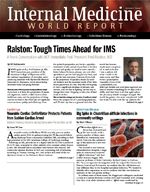H1N1 shedding danger outlasts CDC return-to-work guidelines
H1N1 shedding danger outlasts CDC return-to-work guidelines
Danger of virus spread indicates needed extension of period before infected workers should be allowed to return
By Kurt Ullman
Little is known about the shedding behavior of the pandemic influenza (H1N1) 2009 virus. However, shedding is an important component of transmission characteristics and can have a profound impact on spread to others, especially susceptible populations.
“We decided to do this investigation because H1N1 was a new influenza virus, and not much was known about transmission characteristics, including duration of shedding in scenarios where vulnerable people can be exposed such as health care settings,” said co-author Jeffrey Duchin, MD, chief of the Communicable Disease Epidemiology & Immunization Section, Public Health, Seattle & King County. “Understanding how long the H1N1 influenza virus is shed after infection is one important piece of information related to understanding the duration of communicability.”
In September of 2009, an outbreak of the virus occurred among medical residents who had attended a retreat two days earlier. They were contacted and asked to participate in this study. Participants met the inclusion criteria if they had been in attendance at the retreat and had laboratory evidence of influenza by direct fluorescent antibody (DFA) testing or reverse transcription polymerase chain reaction (RT-PCR) from a specimen obtained within three days of the end of retreat.
All who met the criteria were asked to record symptoms and oral temperature daily for two weeks or until no longer showing symptoms. They self-administered nasal washings at specific intervals for up to two weeks. Attendees were also asked to give demographic data, information on any underlying health conditions, compliance with any prophylactic measures prescribed, and symptoms via an online questionnaire.
When they met Centers for Disease Control and Prevention (CDC) criteria for returning to work, 12 of 16 healthcare workers (75%) (95% confidence interval [CI] 48%-93%) had virus detected by PCR, and 9 (56%) (95% CI 30%-80%) had virus detected by culture. Fever was not associated with shedding duration (p = 0.65).
“We were surprised to find that a larger proportion of healthcare workers in our study had H1N1 virus detectable (by PCR and/or culture) at the time they met current criteria for returning to work—24 hours after resolution of fever,” said Dr. Duchin. “This suggests that healthcare workers might shed virus even when meeting CDC exclusion guidelines. Further research is needed to clarify the association between viral shedding, symptoms, and infectiousness.”
He also stressed that these results are another indication of the importance of prevention, especially when interacting with those who might be prone to a serious infection.
“These results suggest that influenza may be transmitted by persons who have recently been infected, even when they are no longer febrile or appearing ill,” said Dr. Duchin. “Therefore, get vaccinated each season to protect yourself, and recommend vaccination to your patients to protect them. Also use good infection control practices at all times, including when returning to work after an illness.”
Source:Kay M, et al. Shedding on pandemic (H1N1) 2009 virus among health care personnel, Seattle, Washington, USA. Emerging Infectious Diseases. 2011;17:
639-644.
